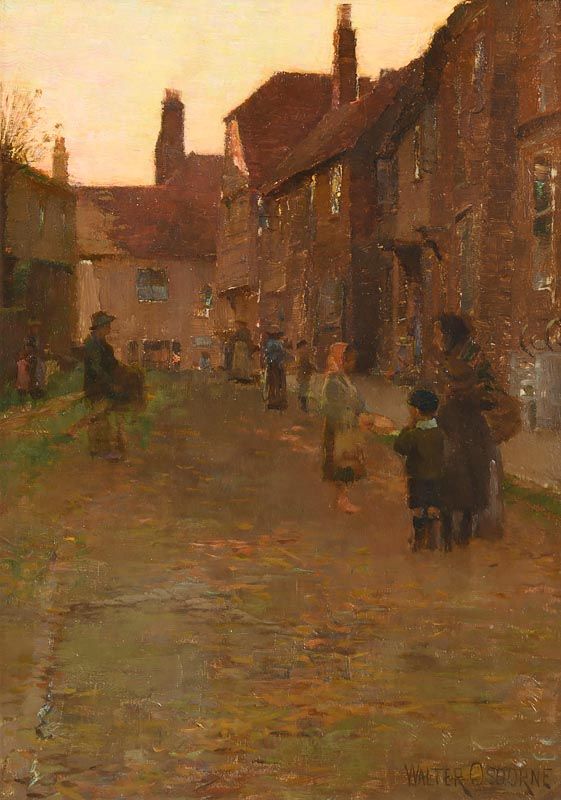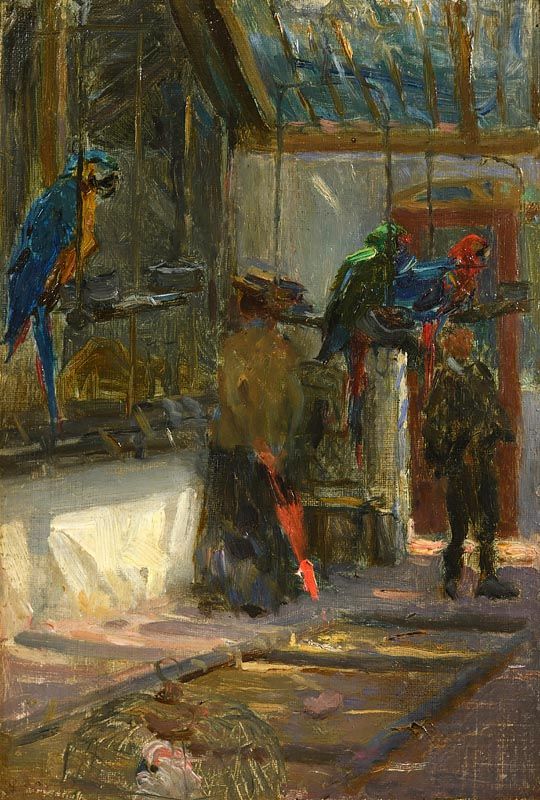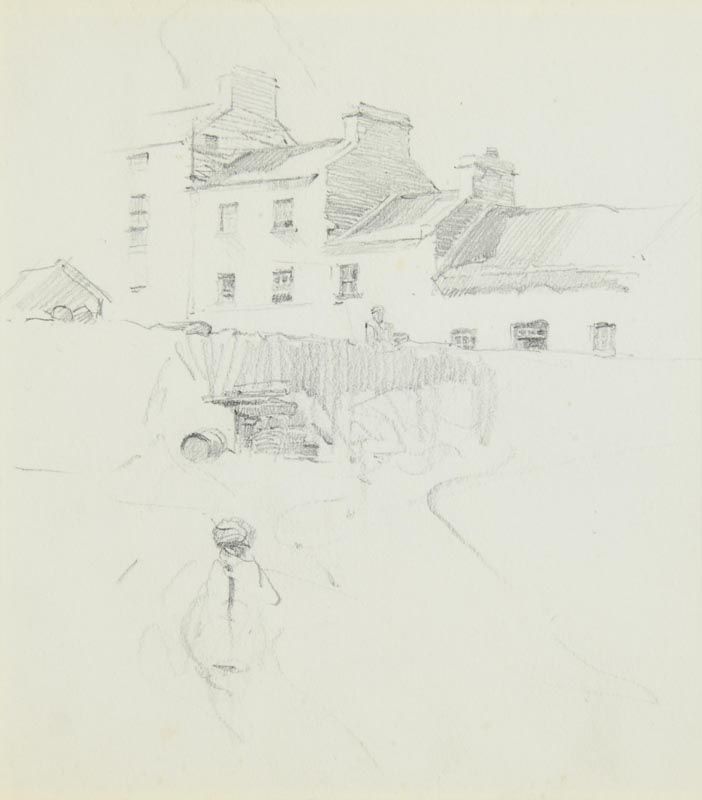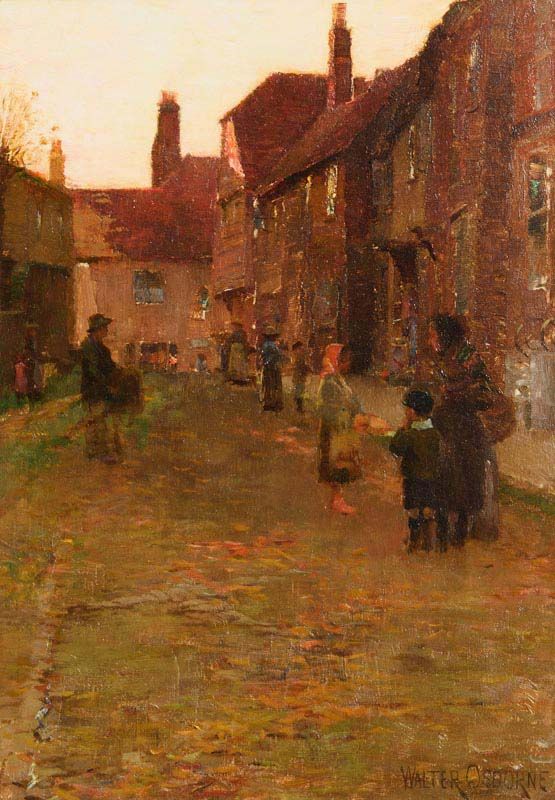Walter Frederick Osborne RHA ROI (1859-1903) Zaandam Oil on canvas, 26.5 x 37cm (10½ x 14½'') Signed, inscribed and dated May 1901 indistinctly on the turned edge of the canvas Provenance: With Milmo-Penny Fine Art, Dublin 1991; Sotheby's London, The Irish Sale, 11/5/06, Lot 34; Private Collection. Exhibited: Milmo-Penny Fine Art, 'Exhibition of Irish Art', Dublin June 1991, No.14. A stream leads from the left-hand side of the composition, winding through flat landscape towards the horizon, beneath an overcast sky of wind-tossed clouds. On the left is a windmill, in the centre another windmill and on the right a low cottage or barn. The scene is set in Zaandam in The Netherlands. A keen traveller, Walter Osborne is better known for his village scenes with figures and landscapes painted in Belgium, Brittany, England and the West of Ireland. But, in the 1890s, he also visited Spain and The Netherlands, in the company of Walter Armstrong Director of the National Gallery of Ireland. He visited Amsterdam in c.1894, painted in Zaandam in 1895, then travelled in Holland with Armstrong in 1896, painting a small number of watercolours and oils on these trips (1). Zaandam was a picturesque village in the Zaanstad region, about seven miles north of Amsterdam. In the seventeenth century it had become a centre for ship building. In 1797 it attracted an important visitor, the Russian Tzar, Peter the Great, who came to study shipbuilding. On several visits he stayed in a small wooden house. This was known as the Czaar Petershuisje and became a tourist attraction in the town (2). In the nineteenth century, Zaandam and its surroundings became a popular tourist area, attracted by its rows of brightly painted houses, masts and canals and its distinctive windmills, becoming known as La Chine dHollande, because of its slightly oriental appearance (3). The village attracted artists including French Impressionist Claude Monet in the 1870s, who painted a series of colourful pictures there. In his picture Zaandam, Osborne does not paint in the village but in the surrounding countryside. But the representation of windmills, cottages and masts on the horizon suggest that there is human presence nearby. The light is overcast, the sky filled with clouds, vigorously painted. Some of these, as well as one windmill, are reflected in the stream, lighting up part of the foreground. The moss green of the moor is rapidly painted so that the vigorous brushstrokes are visible. Osborne employs quite a rough-weave canvas, its grain showing through where the paint is thin. The pinkish tones in the left-hand horizon recur in the cloud in the centre of the sky. Much of his work of the 1890s is more impressionistic and light-filled. But Zaandam has affinities with the pictures of the painters of the Hague School, the great Dutch Realist landscapes of the mid-century, in its grey and green tones and subdued atmosphere, for example with Allotments near the Hague by Jacob Maris (Haags Gemeeentemuseum, the Hague), which also shows a canal winding into the landscape and a brooding, cloud-filled sky (4). Osbornes Zaandam may relate to a watercolour Near Zaandam, featuring a landscape with windmills, painted in 1895 (5). However, an inscription on the edge of the current canvas reads Walter Osborne Zaandam May 1901, suggesting that he may also have visited the village at this later date. Julian Campbell, September 2019 See Jeanne Sheehy, Walter Osborne, Ballycotton 1974 and Jeanne Sheehy, Walter Osborne, National Gallery of Ireland 1983. Osbornes painting on the Canals, Amsterdam was exhibited at Institute of Painters in Oil Colours, 1894-95 (Sheehy, 1974, cast. No. 419). A watercolour Canal, Amsterdam was included in the Osborne Memorial Exhibition, 1903-1904. Martin Dunford and Jack Holland, Amsterdam, 1997, p.319. Amsterdam, 1997, p.319. Hague artists such as Maris, Gerard Bilders Paul Gabriel and Jan Weissenbruch painted flat landscapes with canals and windmills with to
Walter Frederick Osborne RHA ROI (1859-1903) Zaandam Oil on canvas, 26.5 x 37cm (10½ x 14½'') Signed, inscribed and dated May 1901 indistinctly on the turned edge of the canvas Provenance: With Milmo-Penny Fine Art, Dublin 1991; Sotheby's London, The Irish Sale, 11/5/06, Lot 34; Private Collection. Exhibited: Milmo-Penny Fine Art, 'Exhibition of Irish Art', Dublin June 1991, No.14. A stream leads from the left-hand side of the composition, winding through flat landscape towards the horizon, beneath an overcast sky of wind-tossed clouds. On the left is a windmill, in the centre another windmill and on the right a low cottage or barn. The scene is set in Zaandam in The Netherlands. A keen traveller, Walter Osborne is better known for his village scenes with figures and landscapes painted in Belgium, Brittany, England and the West of Ireland. But, in the 1890s, he also visited Spain and The Netherlands, in the company of Walter Armstrong Director of the National Gallery of Ireland. He visited Amsterdam in c.1894, painted in Zaandam in 1895, then travelled in Holland with Armstrong in 1896, painting a small number of watercolours and oils on these trips (1). Zaandam was a picturesque village in the Zaanstad region, about seven miles north of Amsterdam. In the seventeenth century it had become a centre for ship building. In 1797 it attracted an important visitor, the Russian Tzar, Peter the Great, who came to study shipbuilding. On several visits he stayed in a small wooden house. This was known as the Czaar Petershuisje and became a tourist attraction in the town (2). In the nineteenth century, Zaandam and its surroundings became a popular tourist area, attracted by its rows of brightly painted houses, masts and canals and its distinctive windmills, becoming known as La Chine dHollande, because of its slightly oriental appearance (3). The village attracted artists including French Impressionist Claude Monet in the 1870s, who painted a series of colourful pictures there. In his picture Zaandam, Osborne does not paint in the village but in the surrounding countryside. But the representation of windmills, cottages and masts on the horizon suggest that there is human presence nearby. The light is overcast, the sky filled with clouds, vigorously painted. Some of these, as well as one windmill, are reflected in the stream, lighting up part of the foreground. The moss green of the moor is rapidly painted so that the vigorous brushstrokes are visible. Osborne employs quite a rough-weave canvas, its grain showing through where the paint is thin. The pinkish tones in the left-hand horizon recur in the cloud in the centre of the sky. Much of his work of the 1890s is more impressionistic and light-filled. But Zaandam has affinities with the pictures of the painters of the Hague School, the great Dutch Realist landscapes of the mid-century, in its grey and green tones and subdued atmosphere, for example with Allotments near the Hague by Jacob Maris (Haags Gemeeentemuseum, the Hague), which also shows a canal winding into the landscape and a brooding, cloud-filled sky (4). Osbornes Zaandam may relate to a watercolour Near Zaandam, featuring a landscape with windmills, painted in 1895 (5). However, an inscription on the edge of the current canvas reads Walter Osborne Zaandam May 1901, suggesting that he may also have visited the village at this later date. Julian Campbell, September 2019 See Jeanne Sheehy, Walter Osborne, Ballycotton 1974 and Jeanne Sheehy, Walter Osborne, National Gallery of Ireland 1983. Osbornes painting on the Canals, Amsterdam was exhibited at Institute of Painters in Oil Colours, 1894-95 (Sheehy, 1974, cast. No. 419). A watercolour Canal, Amsterdam was included in the Osborne Memorial Exhibition, 1903-1904. Martin Dunford and Jack Holland, Amsterdam, 1997, p.319. Amsterdam, 1997, p.319. Hague artists such as Maris, Gerard Bilders Paul Gabriel and Jan Weissenbruch painted flat landscapes with canals and windmills with to






-lg.jpg)








Testen Sie LotSearch und seine Premium-Features 7 Tage - ohne Kosten!
Lassen Sie sich automatisch über neue Objekte in kommenden Auktionen benachrichtigen.
Suchauftrag anlegen